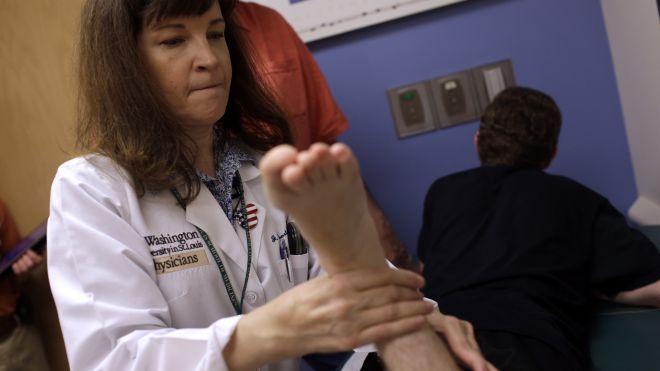
Dr. Jan Brunstrom-Hernandez gently but sternly admonishes a teenage cerebral palsy patient who clearly hasn't been doing his exercises, stressing the importance of keeping muscles loose and limber. “We know it's not fair, but that's the way it is,” Brunstrom-Hernandez tells 15-year-old patient Sam Ward. “Do you hear me? I know what I'm talking about.” Brunstrom-Hernandez, who founded the Cerebral Palsy Center at St. Louis Children's Hospital 15 years ago, has cerebral palsy, giving her a special empathy for the people she treats. Cerebral palsy is a broad diagnostic term referring to disorders that affect movement and posture. It is caused by injury or abnormal development of the brain, usually before birth. Many patients suffer from other afflictions, too, such as speech or hearing difficulties. Symptoms vary greatly. Brunstrom-Hernandez, 50, was surrounded by doctors from a young age as she coped with the disorder. She figures that's a big reason she knew as a small girl she wanted to be a doctor. Still, she initially balked at specializing in treating others with cerebral palsy. “I didn't want to be surrounded by more of me,” she said. “I didn't feel good about myself because of my disability.” A chat in 1997 with Dr. Mike Noetzel at St. Louis Children's Hospital changed all that. At the time, Brunstrom-Hernandez was doing research on cerebral palsy and was surprised to learn treatment hadn't progressed much beyond the treatment she received in the 1960s. He suggested she launch a cerebral palsy clinic. “All I said was, `You've got some good ideas. I think people would listen to you. Let's at least try to start something,'” he recalled. The clinic opened in May 1998. There are many clinics in the U.S. that treat cerebral palsy among many other neurological disorders, but the St. Louis center is unique in its singular focus, said Kaelan Richards of United Cerebral Palsy. Brunstrom-Hernandez and her team of doctors and therapists see patients of all ages - babies to adults - from across the world. The center has treated about 2,000 people since opening 15 years ago. Sam, at the clinic recently with his parents, is in many ways a typical teen. He wore a T-shirt, shorts and sported a sly grin as Brunstrom-Hernandez examined him - even through her motherly admonitions. “She helps me walk better,” he said. “Just be better.” Anna Marie Champion of Atlanta has been bringing her daughter, Morgan, on the 11-hour trip to the St. Louis clinic for 10 years, since Morgan was 3. Morgan uses a walker but is scholarly and motivated, a seventh-grader who already has earned a college scholarship. “We went to St. Louis and it was a whole different approach,” Champion said. “It has turned her life around completely.” Brunstrom-Hernandez stresses the need for exercise and communication. From childhood, movement was difficult for her. “If the wind was blowing hard enough, I'd fall down,” Brunstrom-Hernandez recalled. Her mother made her keep moving, even requiring her to stand in the kitchen to do dishes when it was the last thing the little girl wanted to do. “She insisted that I not be dependent,” Brunstrom-Hernandez said. “She insisted that I pull my weight. It's a good thing. It made me tough and it made me strong.” Strong, yes, but Brunstrom-Hernandez acknowledged she sometimes felt embarrassed by cerebral palsy. She recalled how she would recoil if she caught a glimpse of mirrored glass showing her struggling to walk. It wasn't until she started the clinic that she embraced who she was and what she could do to help others. “I have gotten as much or more out of taking care of these patients as they have ever gotten from me,” she said. “It changed my life. They saved my life. They taught me how to believe in myself. They taught me how to look at myself differently.” Moving around the clinic, only Brunstrom-Hernandez's gait shows any effects of her cerebral palsy, though rheumatoid arthritis causes her pain. She acknowledges it can be physically exhausting. “I have to work all the time to stay on my feet,” she said. It's a dedication that doesn't go unnoticed by her colleagues. “I think the empathy does come through,” Noetzel said. “Her line is kind of a tough one: If you really want to do best, this is what you need to do. I think there's a much greater acceptance coming from her.”source : http://www.foxnews.com/health/2013/05/15/doctor-with-cerebral-palsy-offers-hope/



